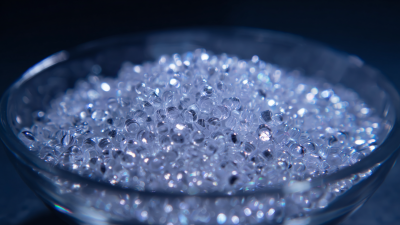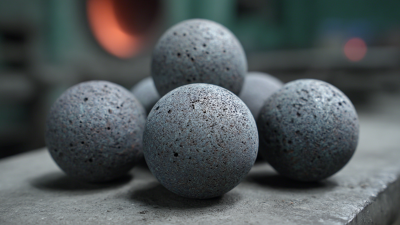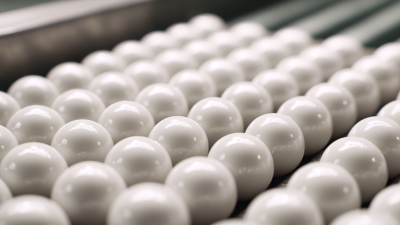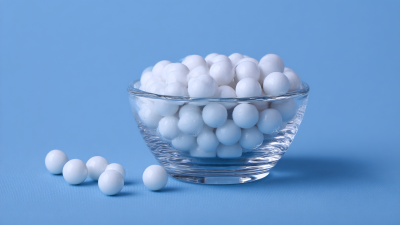Zirconium Ceramic Balls have emerged as a game-changer in various modern industries due to their exceptional properties and versatility. According to a recent report by MarketsandMarkets, the global zirconia ceramics market is projected to reach USD 3.19 billion by 2026, growing at a CAGR of 7.5% from 2021 to 2026. This growth is largely fueled by the increasing demand for advanced materials in high-performance applications, including aerospace, automotive, and biomedical sectors.

Zirconium Ceramic Balls offer remarkable wear resistance, low thermal conductivity, and high chemical stability, making them ideal for use in applications such as grinding media, valves, and bearing components. The ability of these balls to withstand extreme conditions, coupled with their lower environmental impact compared to traditional materials, positions them as a pivotal component in the advancement of sustainable industrial practices, setting the stage for wider adoption in the future.
Zirconium ceramic balls are increasingly recognized for their unique composition and properties, making them a vital component in various modern industries. Composed primarily of zirconium dioxide (ZrO2), these ceramic balls exhibit exceptional hardness and resistance to wear, which is crucial for applications in high-performance bearings and grinding media. According to a report by Grand View Research, the global zirconium market is projected to reach USD 81.54 billion by 2027, reflecting the growing demand for advanced materials like zirconium ceramic balls across sectors such as aerospace, automotive, and manufacturing.
One of the standout features of zirconium ceramic balls is their low thermal conductivity, which enables them to maintain integrity under extreme temperature fluctuations. This characteristic not only enhances the durability of machinery but also contributes to energy efficiency in industrial processes. A study published in the Journal of Advanced Ceramics indicated that zirconium ceramic materials can outperform conventional materials by 30% in terms of lifespan and operational efficiency.
**Tips:** When considering zirconium ceramic balls for your applications, ensure compatibility with the operational environment to maximize their benefits. Regular maintenance and monitoring can further extend the lifespan of these components, leading to increased reliability and reduced downtime in production.
Zirconium ceramic balls have emerged as vital components across various modern industries due to their exceptional properties. One of the key sectors utilizing these balls is the medical industry, where they are deployed in orthopedic implants and dental applications. Their biocompatibility, strength, and resistance to wear make them ideal for use in environments where they must withstand significant stress while minimizing the risk of adverse reactions in the human body.
Another important industry leveraging zirconium ceramic balls is the aerospace sector. These balls are utilized in fuel systems, bearings, and other critical components where reliability and high-performance standards are mandatory. The resistance to corrosion and thermal stability of zirconium ceramics ensure that they can function efficiently under extreme conditions, enhancing the performance and safety of aerospace technologies. Furthermore, the electronics industry is also adopting zirconium ceramic balls for use in capacitors and insulators, capitalizing on their excellent electrical properties and durability in high-temperature environments.
Zirconium ceramic balls are increasingly being recognized for their transformative role in modern manufacturing. These advanced materials exhibit exceptional hardness and chemical resistance, making them ideal for high-performance applications across various industries. With their lightweight and durable nature, zirconium ceramic balls contribute to enhanced efficiency and longevity in equipment, minimizing downtime and maintenance costs.
One significant advantage of zirconium ceramic balls is their suitability for ceramic additive manufacturing, a process that is revolutionizing production methodologies. According to industry reports, this technique allows for complex geometries and reduced material waste, translating to a cost-effective and environmentally friendly approach. Moreover, the adoption of these materials in manufacturing facilitates the creation of more robust and efficient components, particularly in critical sectors such as electronics and automotive.
Tips for manufacturers considering the integration of zirconium ceramic balls include conducting a thorough needs assessment to identify specific applications, as well as staying updated on industry best practices to maximize performance. Collaborating with experts in technical ceramics can further enhance the capabilities of these materials in achieving precision and efficiency. Embracing zicronium technology will undeniably push the boundaries of what is possible in modern manufacturing.
Zirconium ceramic balls have emerged as a superior alternative to traditional materials commonly used in various industrial applications. Unlike steel or plastic balls, zirconium ceramic balls exhibit remarkable hardness, wear resistance, and chemical stability. This makes them particularly advantageous in high-stress environments such as manufacturing processes, where durability is paramount.
Unlike metal counterparts, zirconium ceramic balls do not corrode, leading to longer service life and reduced maintenance costs.
When comparing zirconium ceramic balls to traditional materials, one of the most significant advantages is their lightweight nature. This characteristic not only enhances operational efficiency by reducing energy consumption but also minimizes the risk of damage associated with heavy materials. Additionally, zirconium's biocompatibility and low thermal conductivity make it an excellent choice for industries such as pharmaceuticals and food processing, where contamination and heat transfer can compromise product integrity.
As industries continue to evolve, the shift towards zirconium ceramic balls signifies a move towards higher performance and sustainability.
Incorporating zirconium ceramic balls into production processes can greatly enhance operational efficiency across various industries. According to a report by Markets and Markets, the global demand for ceramic balls is expected to reach $1.5 billion by 2025, driven by their unique properties such as high wear resistance, low thermal conductivity, and chemical inertness. These attributes make zirconium ceramic balls an excellent choice for applications in aerospace, pharmaceuticals, and food processing where reliability and performance are paramount.
Best practices for integrating zirconium ceramic balls start with a comprehensive understanding of the specific requirements of the production line. For instance, in the pharmaceutical industry, maintaining stringent hygiene standards is crucial. Zirconium ceramic balls provide an advantage as they are non-reactive and can withstand sterilization processes without degradation. Additionally, when incorporating these materials into grinding and milling processes, adopting optimal ball-to-powder ratios is essential. A study published in the Journal of Materials Science indicates that the right ratios can significantly improve particle size distribution and enhance overall process efficiency. By focusing on these best practices, industries can leverage the advantages of zirconium ceramic balls to optimize production while ensuring product integrity and safety.
| Industry | Application | Benefits | Best Practices |
|---|---|---|---|
| Aerospace | Bearings and valves | High temperature resistance, low wear | Use in extreme conditions, regular inspections |
| Manufacturing | Grinding and milling | Longer lifespan, reduced contamination | Optimize milling processes, regular maintenance |
| Healthcare | Dental applications | Biocompatibility, aesthetic qualities | Rigorous testing for safety, advanced shaping techniques |
| Energy | Fuel cells and batteries | High conductivity, enhanced efficiency | Incorporate into new designs, focus on scalability |






